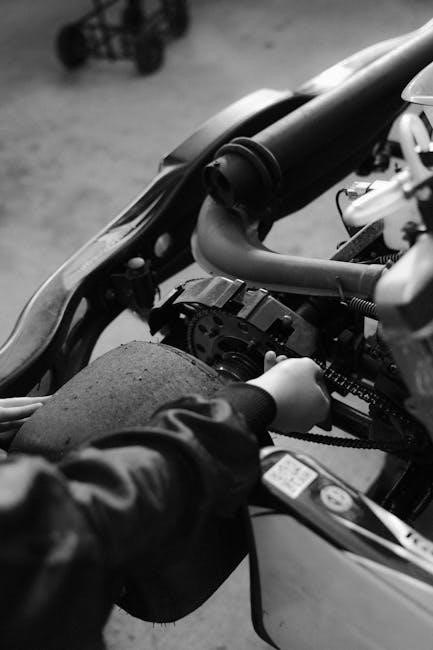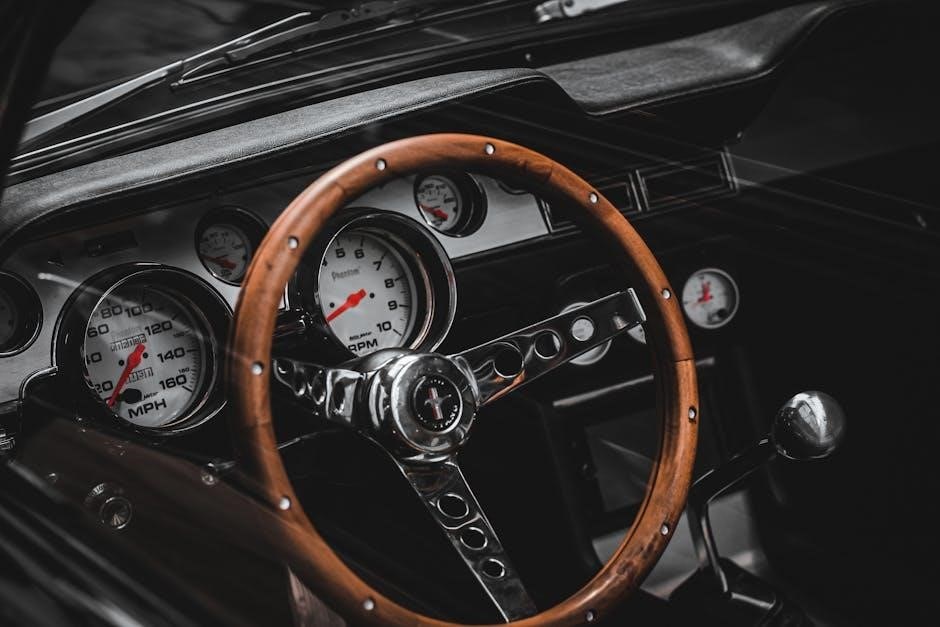manual transmission 7 speed
A 7-speed manual transmission offers precise gear control, optimizing performance and fuel efficiency. Designed for drivers seeking enhanced engagement, it provides a wider gear ratio spread, catering to various driving conditions while maintaining smooth acceleration and responsive handling.
1.1 Definition and Overview
A 7-speed manual transmission is a type of gearbox that allows drivers to manually select one of seven forward gear ratios, plus reverse. It operates through a clutch pedal and gearshift, enabling precise control over acceleration and engine speed. This configuration is designed to optimize performance, fuel efficiency, and driving experience, particularly in vehicles requiring a wide range of torque and speed capabilities. The additional gear ratios compared to traditional 5- or 6-speed transmissions provide smoother transitions and better adaptability to varying driving conditions.
1.2 Importance of Manual Transmissions in Modern Vehicles
Manual transmissions remain vital in modern vehicles due to their ability to enhance fuel efficiency and deliver precise driver control. They offer a more engaging driving experience and are often preferred by enthusiasts. Lower production and maintenance costs compared to automatics make them a practical choice. Additionally, manual transmissions are well-suited for specific driving conditions, providing better responsiveness and connection to the vehicle.

History and Evolution of Manual Transmissions
Manual transmissions have evolved from basic 3-speed systems to advanced 7-speed designs, offering improved performance, efficiency, and driver control over the years.
2.1 Early Developments in Manual Gearboxes
Manual transmissions originated in the early 20th century, with the first 3-speed systems emerging in basic cars. These early gearboxes were non-synchronized, requiring drivers to manually match engine and gear speeds. The 1930s introduced 4-speed transmissions, offering better control and efficiency. Early designs focused on durability and simplicity, with synchronization becoming standard in the 1950s. These advancements laid the groundwork for modern manual transmissions, including the 7-speed, by refining gear engagement and driver interaction. Each milestone improved performance and ease of use, setting the stage for today’s sophisticated systems.
2.2 Transition to 7-Speed Manual Transmission
The transition to 7-speed manual transmissions marked a leap in engineering, addressing the need for better fuel efficiency and performance. By expanding the gear ratio spread, the 7-speed allows for optimized power delivery across various driving conditions. This development catered to both everyday commuting and high-performance driving, offering smoother acceleration and reduced engine strain. The additional gear provided a finer balance between speed and torque, enhancing overall driving dynamics. This innovation reflects the automotive industry’s commitment to improving efficiency without sacrificing driver engagement, making the 7-speed a versatile choice for modern vehicles.

Benefits and Advantages of 7-Speed Manual Transmission
The 7-speed manual transmission enhances fuel efficiency and performance, offering a wide gear ratio spread for better control and driving satisfaction. It reduces maintenance costs and extends engine life.
3.1 Improved Fuel Efficiency
The 7-speed manual transmission optimizes fuel efficiency by providing a wider range of gear ratios. This allows drivers to maintain optimal engine speed in various driving conditions, reducing fuel consumption. With more gears, the engine operates within its most efficient RPM range, especially during highway driving or uphill climbs. Additionally, precise control over gear selection enables drivers to avoid excessive revving, further enhancing fuel economy. This makes the 7-speed manual a cost-effective choice for both city and long-distance driving scenarios.
3.2 Enhanced Driver Control and Performance
The 7-speed manual transmission offers enhanced driver control and performance by providing a broader range of gear ratios. This allows for smoother acceleration and precise shifting, enabling drivers to maintain optimal engine speed during acceleration. The additional gear ratios enable better optimization of engine performance, particularly in performance driving scenarios. Drivers can experience a more connected and engaging driving experience, with greater control over power delivery and handling. This makes the 7-speed manual transmission a preferred choice for enthusiasts seeking both precision and performance.

Design and Engineering of 7-Speed Manual Transmission
The 7-speed manual transmission features sophisticated engineering with a wide gear ratio spread, optimized for both performance and efficiency. Its design incorporates advanced components like the clutch and synchronizers, ensuring smooth and precise gear changes. The use of high-strength materials enhances durability while maintaining lightweight construction, making it a reliable choice for modern vehicles.
4.1 Gear Ratio Spread and Engineering
The 7-speed manual transmission’s gear ratio spread is meticulously engineered to optimize performance across various driving conditions. By offering a broader range of ratios, it ensures smoother acceleration and better fuel efficiency. Lower gears provide ample torque for climbing steep inclines, while higher gears minimize engine strain at high speeds. This strategic engineering allows drivers to maintain optimal RPMs, enhancing both power delivery and driving comfort. The precise calibration of each gear ratio contributes to a seamless shifting experience, making it ideal for both city commutes and spirited driving on winding roads.
4.2 Components and Construction
A 7-speed manual transmission consists of key components such as gears, shafts, bearings, and a casing. The gears are precision-engineered to ensure smooth interaction and durability. Input and output shafts transfer power, while bearings reduce friction and enhance efficiency. The transmission casing is typically made of durable materials like aluminum or steel to withstand stress. Internal components are carefully synchronized to provide precise shifting. Modern designs incorporate advanced materials and coatings to minimize wear and tear, ensuring long-term reliability and consistent performance across all gear ranges.

Driving Techniques for 7-Speed Manual Transmission
Mastering a 7-speed manual requires smooth shifting, precise clutch control, and adaptive throttle input. Drivers must utilize all gears effectively to optimize performance, fuel efficiency, and driving comfort across various conditions.
5.1 Shifting Strategies and Best Practices
Smooth shifting in a 7-speed manual requires precise clutch control and timely gear changes; Drivers should listen to engine RPMs, feel resistance, and use the clutch smoothly to avoid jerking. Matching engine speed to the desired gear ensures seamless transitions. Downshifting before braking helps maintain control, while avoiding over-revving protects the engine. Using all gears appropriately maximizes fuel efficiency and performance. Regular practice and attention to the vehicle’s response refine shifting techniques, making driving more enjoyable and efficient.
5.2 Mastering Downshifting and Braking
Mastering downshifting and braking is essential for smooth and controlled driving with a 7-speed manual. Downshifting before braking helps reduce speed gradually, preventing brake wear and maintaining stability. Use engine braking by downshifting into lower gears before entering turns or descending hills. Avoid sudden downshifts, as they can cause skidding or loss of control. Proper timing and gear selection ensure a balanced approach to slowing down, enhancing safety and driving precision. Practice coordination between clutch and brake pedals to refine this technique.

Maintenance and Care for 7-Speed Manual Transmission
Regular inspections, fluid checks, and addressing issues like low transmission fluid or damaged gears are crucial for maintaining optimal performance and longevity of a 7-speed manual transmission.
6.1 Regular Inspections and Fluid Checks
Regular inspections of the 7-speed manual transmission involve checking for worn gears, damaged synchronizers, and leaks. Fluid levels should be monitored to ensure proper lubrication and smooth shifting. Inspecting the clutch and shifter linkage for wear is also essential. Addressing issues early prevents costly repairs and maintains performance. Routine checks every 30,000 miles are recommended to identify potential problems before they escalate. Proper maintenance ensures the transmission operates efficiently, providing reliable service over its lifespan.
6.2 Common Issues and Repairs
Common issues with 7-speed manual transmissions include difficulty shifting gears, clutch wear, and synchronizer problems. Low transmission fluid levels or contamination can cause improper engagement. Repairs often involve replacing worn components like the clutch, synchronizer rings, or gearsets. Addressing these issues early prevents further damage. If gears are damaged due to improper shifting, professional replacement is necessary. Regular maintenance and prompt repairs ensure optimal performance and extend the transmission’s lifespan, avoiding costly overhauls. Early detection of problems is key to maintaining smooth operation and driver control.

Comparison with Other Transmission Types
The 7-speed manual transmission is distinct from automatic and dual-clutch transmissions, offering precise driver control and efficiency. It excels in performance and fuel economy, appealing to enthusiasts who value direct engagement and driving dynamics.
7.1 7-Speed Manual vs. Automatic Transmissions
The 7-speed manual transmission offers superior fuel efficiency and driver engagement compared to automatics. With precise gear control, it reduces engine revving at higher speeds, lowering fuel consumption. Automatics, while convenient, often lag in responsiveness and may consume more fuel. Manuals provide a direct connection to the vehicle, enhancing performance and driving satisfaction, making them a preferred choice for enthusiasts seeking optimal control and efficiency.
7.2 7-Speed Manual vs. Dual-Clutch Transmissions
The 7-speed manual transmission offers a more engaging driving experience with precise control, whereas dual-clutch transmissions provide faster shifting and convenience. Manuals excel in fuel efficiency and reliability, while DCTs deliver quicker acceleration and reduced driver effort. Both cater to different preferences: manuals for purists seeking connection, and DCTs for those valuing speed and ease. Each has its niche, balancing performance, efficiency, and driver engagement uniquely.

Future Trends in Manual Transmission Technology
Future trends include integrating manual transmissions with hybrid and electric vehicles, alongside advancements in gearbox design for improved efficiency and driving performance.
8.1 Innovations in Gearbox Design
Modern gearbox designs for 7-speed manuals focus on lightweight materials and modular construction to enhance durability and reduce weight. Advanced gear ratio spreads optimize performance across various driving conditions. Innovations include improved synchronizer systems for smoother shifting and reduced wear. Integration with hybrid and electric powertrains is also being explored, ensuring manual transmissions remain relevant in eco-focused vehicles. Additionally, smart technologies like adaptive shifting algorithms and clutchless gear changes are being developed to bridge the gap between manual control and automatic convenience, offering drivers the best of both worlds while maintaining fuel efficiency and driving excitement.
8.2 Integration with Hybrid and Electric Vehicles
The integration of 7-speed manual transmissions into hybrid and electric vehicles represents a significant leap in combining traditional driving engagement with modern eco-friendly technology. Manufacturers are exploring ways to pair manual gearboxes with electric motors to maintain driver control while enhancing efficiency. Lightweight components and optimized gear ratios are being developed to complement hybrid powertrains. This integration aims to preserve the tactile experience of manual shifting in electric vehicles, ensuring that the joy of driving remains intact even as the automotive industry transitions to sustainable energy solutions.
The 7-speed manual transmission offers a blend of performance, efficiency, and driver engagement, making it a preferred choice for enthusiasts. Its evolution and integration into modern vehicles highlight its enduring relevance in the automotive world.
9.1 Summary of Key Points
The 7-speed manual transmission enhances fuel efficiency and driver control, offering a wide gear ratio spread for optimal performance across various driving conditions. Its design combines advanced engineering with durable components, ensuring smooth shifting and longevity. Regular maintenance, including fluid checks and inspections, is crucial for sustained functionality. Driving techniques like strategic shifting and downshifting improve overall efficiency and driving experience. While it excels in performance vehicles, its relevance in modern cars is debated due to rising competition from automatic and dual-clutch transmissions. Nonetheless, the 7-speed manual remains a preferred choice for driving enthusiasts worldwide.
9.2 Final Thoughts on the 7-Speed Manual Transmission
The 7-speed manual transmission represents a pinnacle of driver engagement, blending tradition with modern innovation. Its precise control and wide gear range make it a favorite among enthusiasts, offering unparalleled connection to the vehicle. While automatic and dual-clutch transmissions gain popularity, the 7-speed manual remains a testament to the joy of driving. Its future may face challenges, but for those who value the tactile experience of shifting gears, it continues to be an indispensable option, striking a perfect balance between performance and driver satisfaction in an ever-evolving automotive landscape.

